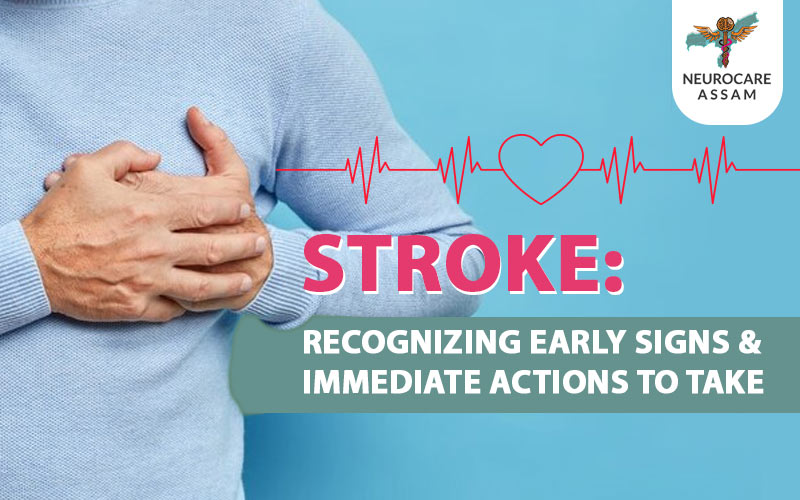
Stroke: Recognizing Early Signs & Immediate Actions to Take
A stroke is a medical emergency that occurs when the blood supply to a part of the brain is interrupted or reduced, preventing brain tissue from getting the oxygen and nutrients it needs. Brain cells begin to die within minutes, so early detection and prompt treatment are crucial. Understanding the early signs and symptoms of a stroke, along with immediate actions to take, can save lives and improve recovery outcomes.
Early Signs and Symptoms
The key to recognizing a stroke is to act FAST:
Face Drooping: One side of the face may droop or feel numb. Ask the person to smile, and see if the smile is uneven.
Arm Weakness: One arm may feel weak or numb. Ask the person to raise both arms. Does one arm drift downward?
Speech Difficulty: Speech may be slurred or difficult to understand. Ask the person to repeat a simple sentence. Are they able to repeat it correctly?
Time to Call Emergency Services: If someone shows any of these symptoms, even if they go away, call emergency services immediately. Time is critical.
Additional Symptoms
Other signs and symptoms can also indicate a stroke, and they may appear suddenly:
Sudden numbness or weakness in the face, arm, or leg, especially on one side of the body.
Sudden confusion, trouble speaking, or understanding speech.
Sudden trouble seeing in one or both eyes.
Sudden trouble walking, dizziness, loss of balance, or lack of coordination.
Sudden severe headache with no known cause.
Immediate Actions to Take
If you suspect someone is having a stroke, take the following steps immediately:
Call Emergency Services: Dial your local emergency number right away. Time is of the essence.
Stay Calm: Keep calm to help the person stay calm. Panic can exacerbate the situation.
Keep the Person Safe: Ensure the person is in a safe position, ideally lying down with their head slightly elevated.
Check for Breathing: Ensure the person is breathing. If they are not, begin CPR if you are trained to do so.
Do Not Give Food or Drink: Avoid giving the person anything to eat or drink, as it might cause choking or complications.
Note the Time: Record the time when symptoms first appeared. This information is crucial for medical personnel.
Risk Factors
Certain factors increase the risk of stroke, including:
High blood pressure: The leading cause of strokes.
Diabetes: Can damage blood vessels over time.
Heart disease: Conditions such as atrial fibrillation and coronary artery disease increase stroke risk.
Smoking: Damages blood vessels and increases blood pressure.
High cholesterol: Can lead to plaque buildup in arteries.
Obesity and physical inactivity: Increase the likelihood of high blood pressure, diabetes, and heart disease.
Family history: Genetic factors can play a role.
Prevention and Treatment
Preventing a stroke involves managing risk factors:
Maintain a healthy lifestyle: Eat a balanced diet, exercise regularly, and avoid smoking and excessive alcohol consumption.
Monitor and control blood pressure, cholesterol, and diabetes.
Medications: Your doctor may prescribe medications to help prevent stroke, such as blood thinners or anti-hypertensive drugs.
Emergency Treatment
Immediate treatment is crucial to minimize brain damage and improve outcomes:
Clot-busting drugs: Such as tissue plasminogen activator (tPA), which can dissolve the clot causing the stroke.
Mechanical thrombectomy: A procedure to remove the clot from the blocked artery.
Surgery: In some cases, surgery may be necessary to relieve pressure on the brain or repair damaged blood vessels.
Recovery and Rehabilitation
Stroke recovery varies depending on the severity and location of the stroke. Rehabilitation often involves:
Physical therapy: To regain strength and coordination.
Occupational therapy: To relearn daily activities and adapt to physical limitations.
Speech therapy: To improve communication skills.
Psychological support: To address emotional and cognitive challenges.
Conclusion
Understanding the early signs and symptoms of a stroke and knowing the immediate actions to take are essential for prompt treatment and better recovery outcomes. By recognizing the signs and acting quickly, you can help save lives and reduce the long-term impact of a stroke. Always remember to act FAST if you suspect a stroke and seek immediate medical attention.
For more information, visit Neurocare Assam, call +91 8402068720, or email assamneurocare@gmail.com.



.jpg)

